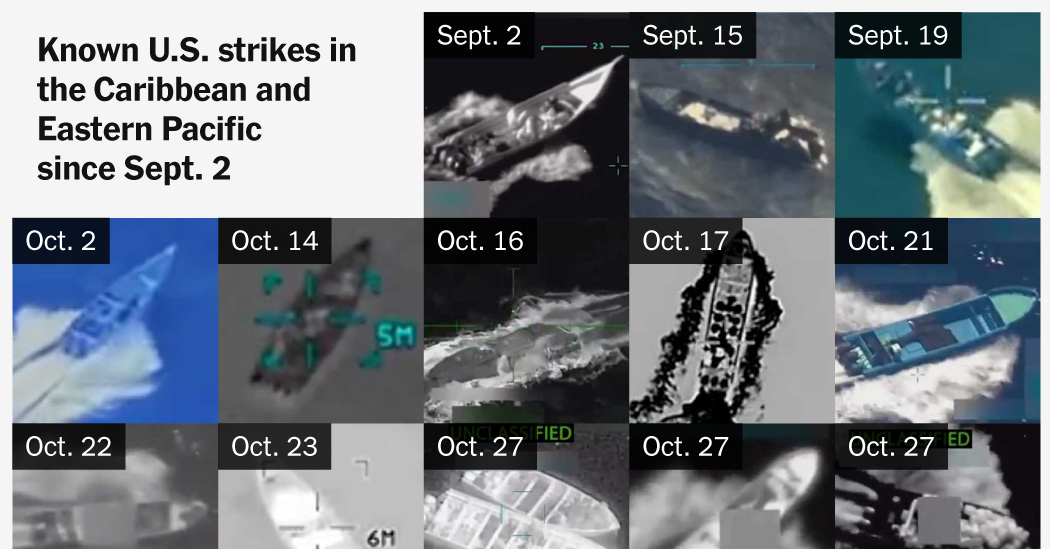Sept. 2

Sept. 15

Sept. 19

Oct. 2

Oct. 14

Oct. 16

Oct. 17

Oct. 21

Oct. 22

Oct. 23

Oct. 27

Oct. 27

Oct. 27

Oct. 29

Since Sept. 2, the U.S. military has been attacking boats in the Caribbean Sea and eastern Pacific Ocean that the Trump administration says are smuggling drugs, killing dozens of people. A broad range of legal specialists on the use of lethal force have said that the strikes are illegal extrajudicial killings because the military is not permitted to deliberately target civilians — even suspected criminals — who do not pose an imminent threat of violence.
This is a drastic departure from past practice. The Coast Guard, with assistance from the Navy, has typically treated maritime drug smuggling in the Caribbean as a law enforcement problem, interdicting boats and arresting people for prosecution if suspicions of illicit cargo turn out to be correct.
The White House has said the killings are lawful. It cited a notice to Congress in which the administration said President Trump “determined” that the United States is in a formal armed conflict with drug cartels and that crews of drug-running boats are “combatants.” It has not supplied a legal theory to bridge the conceptual gulf between drug trafficking and an armed attack.
The New York Times is tracking the boat strikes as details become available. The strike locations and casualty figures are drawn from postings by Mr. Trump or Defense Secretary Pete Hegseth, and have not been independently confirmed by The Times.
Known U.S. strikes in the Caribbean and Eastern Pacific since Sept. 2
Strikes 14
Killed 61
Survivors 3
Each entry is accompanied by an image taken from overhead of the boat or boats in the water shortly before the strike.

This was the sixth strike in the Pacific in eight days.

This was one of three strikes on four boats in one day in the eastern Pacific Ocean. Mr. Hegseth said that Mexican search and rescue authorities had “accepted the case and assumed responsibility for coordinating the rescue,” but he did not release further details.

This was the second strike in the same day in eastern Pacific Ocean.

This was the third strike in the same day in the eastern Pacific Ocean.

This attack, in the Caribbean Sea, was the first at night, Mr. Hegseth said.

This was the second strike in the eastern Pacific Ocean.

This was the first strike in the eastern Pacific Ocean.

Mr. Hegseth described those on the boat as affiliated with Ejército de Liberación Nacional, a Colombian guerrilla group. The strike took place in the Caribbean Sea.

This strike was on a semisubmersible in the Caribbean Sea. Two men from the boat were rescued by the U.S. military and repatriated within days to Colombia and Ecuador.

This strike took place “just off the Coast of Venezuela,” Mr. Trump said.

Colombia’s president said this boat was carrying Colombian citizens.

Officials from the Dominican Republic said they recovered cocaine from the wreckage after this strike.

Colombia’s president said the strike occurred near his country and killed an innocent fisherman.

The first strike on a boat alleged to be carrying drugs was near Trinidad in the Caribbean Sea. The boat appeared to have turned around before being struck.

